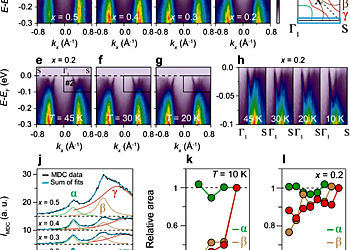Signature of Kondo Hybridisation with an Orbital-Selective Mott Phase in 4d Ca2−xSrxRuO4
Result of the Month
In this article, we report our systematic x- (0.2 ≤ x ≤ 0.5) and T-dependent ARPES results on CSRO. With variation in x and T, a gradual orbital-selective opening of a soft gap is observed in the γ (4dxy)-band with spectral weight transfer from low- to high-binding energy (BE), suggesting the emergence of the OSMP. We also observe unexpected spectral weight suppression in the β-band (4dxz/yz) (but not in the α-band (4dxz/yz)). Considering the results of previous studies, this is indicative of Kondo-hybridisation (KH) between the localised γ- and itinerant β-bands. Our results show a coincidence between the emergence of the OSMP (and KH) and octahedral tilting distortion, implying that the tilting is the key parameter that triggers the OSMP as well as KH. Our results not only provide direct evidence for the OSMP but also constitute the demonstration of possible KH in 4d-orbitals.

Image 2 description: Geometry-, photon energy-, and polarizationdependencies in ARPES measurements
Experimental conditions for ARPES measurements. (ab) Experimental geometries for ARPES measurements using (a) synchrotron-based ARPES system with linearly polarised (π/σ) light (hv = 70 eV), and (b) lab-based ARPES system with un-polarised discharged lamp (He I, hv = 21.2 eV). (c-e) xdependent ARPES data along the Γ1-S direction measured with (c) π-, (d) σ-, and (e) un-polarised light. White and red dashed boxes indicate regions #1 (for the γ-band, 0.6 ≤ kx ≤ 0.8) and #2 (for the β-band, 0.4 ≤ kx ≤ 0.5) from which EDCs shown in Figs. 3 and 5 are obtained, respectively.
Angle-resolved photoemission spectroscopy (ARPES)
ARPES measurements were performed at Seoul National University (SNU) using an unpolarised He-Iα photon source (hv = 21.2 eV) and at the MERLIN beamline (BL) 4.0.3 of the Advanced Light Source, Lawrence Berkeley National Laboratory using both horizontally (π) and vertically (σ) polarised light (hv = 70 eV) (for detailed information, see Supplementary Fig. 2). Spectra were acquired using a DA30-L (SNU) and R8000 (BL 4.0.3) electron analysers from Scienta Omicron with energy resolutions of 10 and 15 meV, respectively. For systematic analysis of x- and T-dependent results, the data were normalised and symmetrised as presented in Supplementary Fig. 1 and a reference46, respectively. Sample cleavage and alkali metal deposition were performed (Supplementary Fig. 8) in situ and measurements were performed in an ultrahigh vacuum better than 5 × 10−11 Torr.
---
AUTHORS:
Minsoo Kim, Junyoung Kwon, Choong H. Kim, Younsik Kim, Daun Chung, Hanyoung Ryu, Jongkeun Jung, Beom Seo Kim, Dongjoon Song, Jonathan D. Denlinger, Moonsup Han, Yoshiyuki Yoshida, Takashi Mizokawa, Wonshik Kyung & Changyoung Kim
---
AUTHORS & INSTITUTES:
Center for Correlated Electron Systems, Institute for Basic Science (IBS), Seoul, 08826, Republic of Korea
- Minsoo Kim, Junyoung Kwon, Choong H. Kim, Younsik Kim, Hanyoung Ryu, Jongkeun Jung, Beom Seo Kim, Dongjoon Song, Wonshik Kyung & Changyoung Kim
Department of Physics & Astronomy, Seoul National University, Seoul, 08826, Republic of Korea
- Minsoo Kim, Junyoung Kwon, Choong H. Kim, Younsik Kim, Hanyoung Ryu, Jongkeun Jung, Beom Seo Kim, Dongjoon Song, Wonshik Kyung & Changyoung Kim
College of Liberal Studies, Seoul National University, Seoul, 08826, Republic of Korea
- Daun Chung
Advanced Light Source (ALS), Lawrence Berkeley National Laboratory, Berkeley, CA, 94720, USA
- Jonathan D. Denlinger
Department of Physics, University of Seoul, Seoul, 02504, Republic of Korea
- Moonsup Han
National Institute of Advanced Industrial Science and Technology (AIST), Tsukuba, 305-8568, Japan
- Yoshiyuki Yoshida
Department of Applied Physics, Waseda University, Tokyo, 169-8555, Japan
- Takashi Mizokawa
---
CORRESPONDING AUTHORS:
Wonshik Kyung: specialtoss@gmail.com
Changyoung Kim: changyoung@snu.ac.kr
---
JOURNAL AND LINK TO PUBLICATION:
npj quantum materials: https://www.nature.com/npjquantmats/
Publication: https://doi.org/10.1038/s41535-022-00471-5

